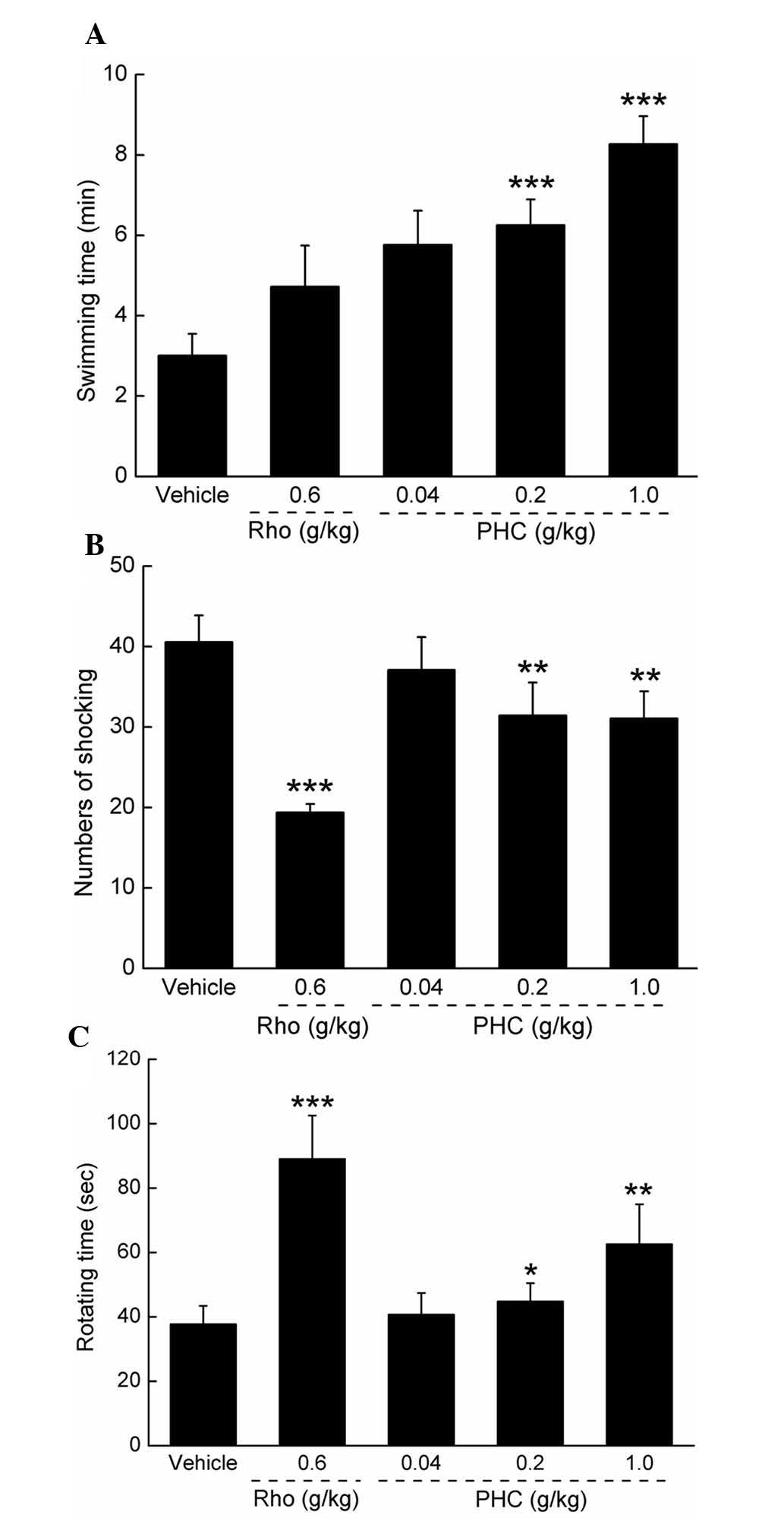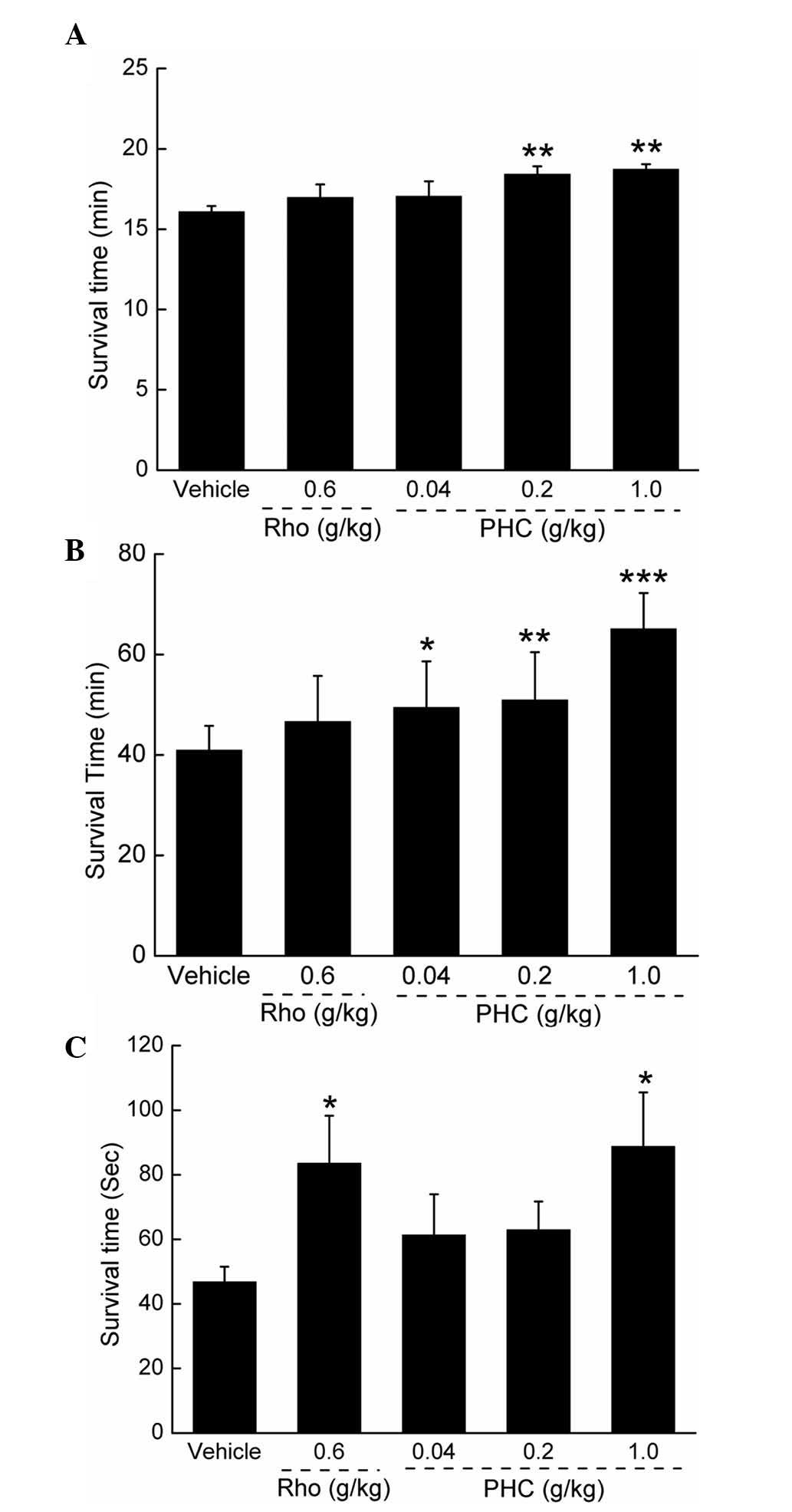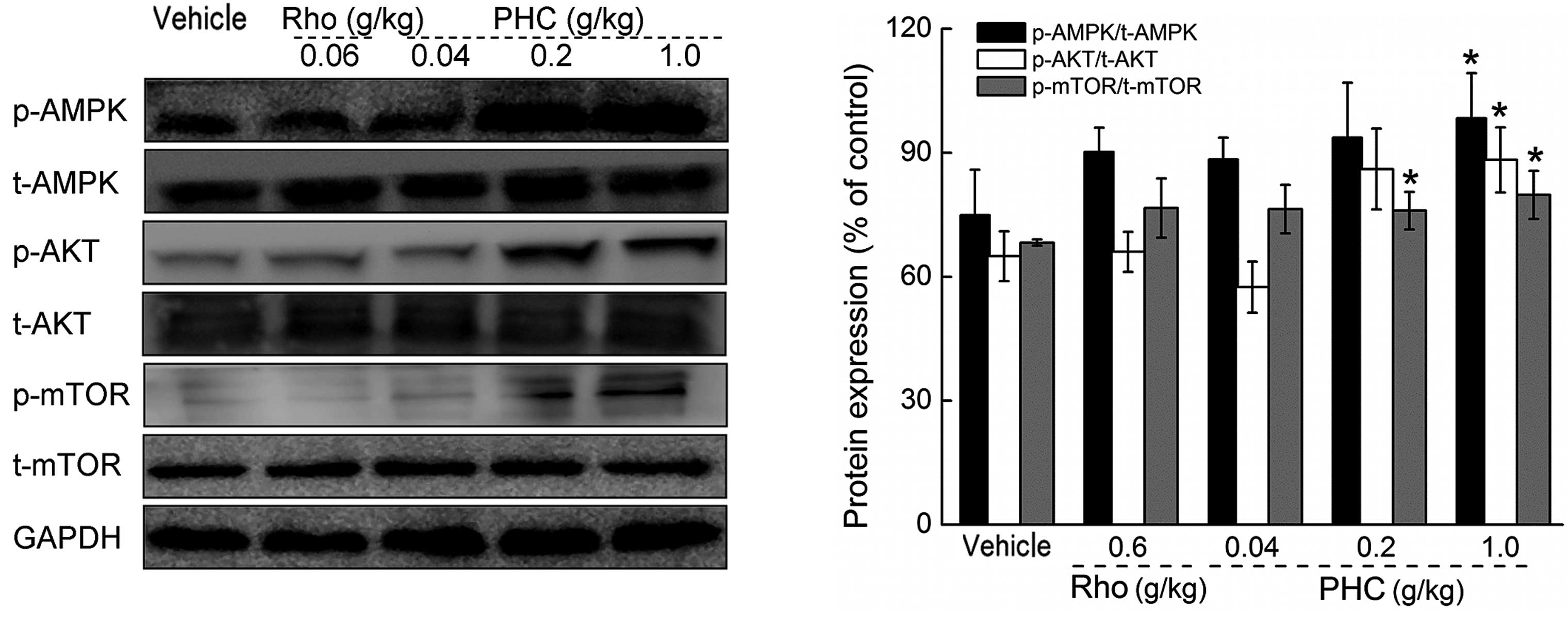|
1
|
Chen PX, Wang SN, Nie SP and Marcone M:
Properties of Cordyceps sinensis: A review. J Funct Foods.
5:550–569. 2013. View Article : Google Scholar
|
|
2
|
Wu Z, Yang Z, Gan D, Fan J, Dai Z, Wang X,
Hu B, Ye H, Abid M and Zeng X: Influences of carbon sources on the
biomass, production and compositions of exopolysaccharides from
Paecilomyces hepiali HN1. Biomass Bioenergy. 67:260–269. 2014.
View Article : Google Scholar
|
|
3
|
Yu SJ, Zhang Y, Li CR, Zhang Q, Ma ZY and
Fan MZ: Optimization of ultrasonic extraction of mycelial
polysaccharides from Paecilomyces hepiali using response surface
methodology and its antioxidant activity. African Journal of
Biotechnology. 10:17241–17250. 2011.
|
|
4
|
Thakur A, Hui R, Hongyan Z, Tian Y,
Tianjun C and Mingwei C: Pro-apoptotic effects of Paecilomyces
hepiali, a Cordyceps sinensis extract on human lung adenocarcinoma
A549 cells in vitro. J Cancer Res Ther. 7:421–426. 2011. View Article : Google Scholar
|
|
5
|
Dong Y, Jing T, Meng Q, Liu C, Hu S, Ma Y,
Liu Y, Lu J, Cheng Y, Wang D and Teng L: Studies on the
antidiabetic activities of Cordyceps militaris extract in
diet-streptozotocin-induced diabetic Sprague-Dawley rats. Biomed
Res Int. 2014:1609802014. View Article : Google Scholar : PubMed/NCBI
|
|
6
|
Dong Y, Hu S, Liu C, Meng Q, Song J, Lu J,
Cheng Y, Gao C, Liu Y, Wang D and Teng L: Purification of
polysaccharides from Cordyceps militaris and their anti-hypoxic
effect. Mol Med Rep. 11:1312–1317. 2015.
|
|
7
|
Zhang W, Wu SZ, Cao JL, Li HM, Li Y, He JG
and Zhang LB: A preliminary study on anti-hypoxia activity of yak
milk powder in vivo. Dairy Science & Technology. 94:633–639.
2014. View Article : Google Scholar
|
|
8
|
You L, Ren J, Yang B, Regenstein J and
Zhao M: Antifatigue activities of loach protein hydrolysates with
different antioxidant activities. J Agric Food Chem.
60:12324–12331. 2012. View Article : Google Scholar : PubMed/NCBI
|
|
9
|
Xu C, Lv J, Lo YM, Cui SW, Hu X and Fan M:
Effects of oat β-glucan on endurance exercise and its anti-fatigue
properties in trained rats. Carbohydr Polym. 92:1159–1165. 2013.
View Article : Google Scholar : PubMed/NCBI
|
|
10
|
Xie Y, Jiang S, Su D, Pi N, Ma C and Gao
P: Composition analysis and anti-hypoxia activity of polysaccharide
from Brassica rapa L. Int J Biol Macromol. 47:528–533. 2010.
View Article : Google Scholar : PubMed/NCBI
|
|
11
|
Zou D, Chen K, Liu P, Chang H, Zhu J and
Mi M: Dihydromyricetin improves physical performance under
simulated high altitude. Med Sci Sports Exerc. 46:2077–2084. 2014.
View Article : Google Scholar : PubMed/NCBI
|
|
12
|
Wu RM, Sun YY, Zhou TT, Zhu ZY, Zhuang JJ,
Tang X, Chen J, Hu LH and Shen X: Arctigenin enhances swimming
endurance of sedentary rats partially by regulation of antioxidant
pathways. Acta Pharmacol Sin. 35:1274–1284. 2014. View Article : Google Scholar : PubMed/NCBI
|
|
13
|
Bijland S, Mancini SJ and Salt IP: Role of
AMP-activated protein kinase in adipose tissue metabolism and
inflammation. Clin Sci (Lond). 124:491–507. 2013. View Article : Google Scholar
|
|
14
|
Dekany M, Nemeskéri V, Györe I, Harbula I,
Malomsoki J and Pucsok J: Antioxidant status of interval-trained
athletes in various sports. Int J Sports Med. 27:112–116. 2006.
View Article : Google Scholar : PubMed/NCBI
|
|
15
|
Bogdanis GC, Stavrinou P, Fatouros IG,
Philippou A, Chatzinikolaou A, Draganidis D, Ermidis G and Maridaki
M: Short-term high-intensity interval exercise training attenuates
oxidative stress responses and improves antioxidant status in
healthy humans. Food Chem Toxicol. 61:171–177. 2013. View Article : Google Scholar : PubMed/NCBI
|
|
16
|
Pandareesh MD and Anand T: Ergogenic
effect of dietary L-carnitine and fat supplementation against
exercise induced physical fatigue in Wistar rats. J Physiol
Biochem. 69:799–809. 2013. View Article : Google Scholar : PubMed/NCBI
|
|
17
|
Gao H, Long Y, Jiang X, Liu Z, Wang D,
Zhao Y, Li D and Sun BL: Beneficial effects of Yerba Mate tea (Ilex
paraguariensis) on hyperlipidemia in high-fat-fed hamsters. Exp
Gerontol. 48:572–578. 2013. View Article : Google Scholar : PubMed/NCBI
|
|
18
|
Ni W, Gao T, Wang H, Du Y, Li J, Li C, Wei
L and Bi H: Anti-fatigue activity of polysaccharides from the
fruits of four Tibetan plateau indigenous medicinal plants. J
Ethnopharmacol. 150:529–535. 2013. View Article : Google Scholar : PubMed/NCBI
|
|
19
|
Liu X, Zhu W, Guan S, Feng R, Zhang H, Liu
Q, Sun P, Lin D, Zhang N and Shen J: Metabolomic analysis of
anti-hypoxia and anti-anxiety effects of Fu Fang Jin Jing Oral
Liquid. PLoS One. 8:e782812013. View Article : Google Scholar : PubMed/NCBI
|
|
20
|
Panossian A and Wagner H: Stimulating
effect of adaptogens: An overview with particular reference to
their efficacy following single dose administration. Phytother Res.
19:819–838. 2005. View
Article : Google Scholar : PubMed/NCBI
|
|
21
|
Du LN, Song J, Wang HB, Li P, Yang ZZ,
Meng LJ, Meng FQ, Lu JH and Teng LR: Optimization of the
fermentation medium for Paecilomyces tenuipes N45 using statistical
approach. African Journal of Microbiology Research. 6:6130–6141.
2012. View Article : Google Scholar
|
|
22
|
Zhang CX and Dai ZR: Anti-hypoxia activity
of a polysaccharide extracted from the Sipunculus nudus L. Int J
Biol Macromol. 49:523–536. 2011. View Article : Google Scholar : PubMed/NCBI
|
|
23
|
Nakagawasai O, Yamada K, Nemoto W,
Fukahori M, Tadano T and Tan-No K: Liver hydrolysate assists in the
recovery from physical fatigue in a mouse model. J Pharmacol Sci.
123:328–335. 2013. View Article : Google Scholar : PubMed/NCBI
|
|
24
|
Nallamuthu I, Tamatam A and Khanum F:
Effect of hydroalcoholic extract of Aegle marmelos fruit on radical
scavenging activity and exercise-endurance capacity in mice. Pharm
Biol. 52:551–559. 2014. View Article : Google Scholar : PubMed/NCBI
|
|
25
|
Wu C, Chen R, Wang XS, Shen B, Yue W and
Wu Q: Antioxidant and anti-fatigue activities of phenolic extract
from the seed coat of Euryale ferox Salisb. and identification of
three phenolic compounds by LC-ESI-MS/MS. Molecules.
18:11003–11021. 2013. View Article : Google Scholar : PubMed/NCBI
|
|
26
|
Cai Y, Lu Y, Chen R, Wei Q and Lu X:
Anti-hypoxia activity and related components of Rhodobryum
giganteum par. Phytomedicine. 18:224–229. 2011. View Article : Google Scholar
|
|
27
|
Bowtell JL, Cooke K, Turner R, Mileva KN
and Sumners DP: Acute physiological and performance responses to
repeated sprints in varying degrees of hypoxia. J Sci Med Sport.
17:399–403. 2014. View Article : Google Scholar
|
|
28
|
Borges P, Oliveira B, Casal S, Dias J,
Conceição L and Valente L: Dietary lipid level affects growth
performance and nutrient utilisation of Senegalese sole (Solea
senegalensis) juveniles. Br J Nutr. 102:1007–1014. 2009. View Article : Google Scholar : PubMed/NCBI
|
|
29
|
Virmani A, Gaetani F, Imam S, Binienda Z
and Ali S: The protective role of L-carnitine against neurotoxicity
evoked by drug of abuse, methamphetamine, could be related to
mitochondrial dysfunction. Ann NY Acad Sci. 965:225–232. 2002.
View Article : Google Scholar : PubMed/NCBI
|
|
30
|
Liu Y, E Q, Zuo J, Tao Y and Liu W:
Protective effect of Cordyceps polysaccharide on hydrogen
peroxide-induced mitochondrial dysfunction in HL-7702 cells. Mol
Med Rep. 7:747–754. 2013.
|
|
31
|
Sureda A, Ferrer MD, Tauler P, Romaguera
D, Drobnic F, Pujol P, Tur JA and Pons A: Effects of exercise
intensity on lymphocyte H2O2 production and antioxidant defences in
soccer players. Br J Sports Med. 43:186–190. 2009. View Article : Google Scholar
|
|
32
|
Peternelj TT and Coombes JS: Antioxidant
supplementation during exercise training: Beneficial or
detrimental? Sports Med. 41:1043–1069. 2011. View Article : Google Scholar : PubMed/NCBI
|
|
33
|
Lortz S, Gurgul-Convey E, Naujok O and
Lenzen S: Overexpression of the antioxidant enzyme catalase does
not interfere with the glucose responsiveness of insulin-secreting
INS-1E cells and rat islets. Diabetologia. 56:774–782. 2013.
View Article : Google Scholar : PubMed/NCBI
|
|
34
|
Su J, Li B, Cheng S, Zhu Z, Sang X, Gui S,
Xie Y, Sun Q, Cheng Z, Cheng J, et al: Phoxim-induced damages of
Bombyx mori larval midgut and titanium dioxide nanoparticles
protective role under phoxim-induced toxicity. Environ Toxicol.
29:1355–1366. 2014. View Article : Google Scholar
|
|
35
|
Wang X, Xing R, Chen Z, Yu H, Li R and Li
P: Effect and mechanism of mackerel (Pneumatophorus japonicus)
peptides for anti-fatigue. Food Funct. 5:2113–2119. 2014.
View Article : Google Scholar : PubMed/NCBI
|
|
36
|
Zhou TB, Ou C, Rong L and Drummen GP:
Effect of all-trans retinoic acid treatment on prohibitin and
renin-angiotensin-aldosterone system expression in hypoxia-induced
renal tubular epithelial cell injury. J Renin Angiotensin
Aldosterone Syst. 15:243–249. 2014. View Article : Google Scholar : PubMed/NCBI
|
|
37
|
Tokunaga C, Yoshino K and Yonezawa K: mTOR
integrates amino acid- and energy-sensing pathways. Biochem Biophys
Res Commun. 313:443–446. 2004. View Article : Google Scholar
|
|
38
|
Ceddia RB: The role of AMP-activated
protein kinase in regulating white adipose tissue metabolism. Mol
Cell Endocrinol. 366:194–203. 2013. View Article : Google Scholar
|
|
39
|
Bonini MG and Gantner BN: The multifaceted
activities of AMPK in tumor progression-why the 'one size fits all'
definition does not fit at all? IUBMB Life. 65:889–896. 2013.
View Article : Google Scholar : PubMed/NCBI
|
|
40
|
Grahame Hardie D: AMP-activated protein
kinase: A key regulator of energy balance with many roles in human
disease. J Intern Med. 276:543–559. 2014. View Article : Google Scholar : PubMed/NCBI
|
|
41
|
Narkar VA, Downes M, Yu RT, Embler E, Wang
YX, Banayo E, Mihaylova MM, Nelson MC, Zou Y, Juguilon H, et al:
AMPK and PPARdelta agonists are exercise mimetics. Cell.
134:405–415. 2008. View Article : Google Scholar : PubMed/NCBI
|
|
42
|
Rios M, Foretz M, Viollet B, Prieto A,
Fraga M, García-Caballero T, Costoya JA and Senaris R: Lipoprotein
internalisation induced by oncogenic AMPK activation is essential
to maintain glioblastoma cell growth. Eur J Cancer. 50:3187–3197.
2014. View Article : Google Scholar : PubMed/NCBI
|
|
43
|
St-Pierre J, Drori S, Uldry M, Silvaggi
JM, Rhee J, Jäger S, Handschin C, Zheng K, Lin J, Yang W, et al:
Suppression of reactive oxygen species and neurodegeneration by the
PGC-1 transcriptional coactivators. Cell. 127:397–408. 2006.
View Article : Google Scholar : PubMed/NCBI
|
|
44
|
Lee HI, Yun KW, Seo KI, Kim MJ and Lee MK:
Scopoletin prevents alcohol-induced hepatic lipid accumulation by
modulating the AMPK-SREBP pathway in diet-induced obese mice.
Metabolism. 63:593–601. 2014. View Article : Google Scholar : PubMed/NCBI
|
|
45
|
Russo E, Andreozzi F, Iuliano R, Dattilo
V, Procopio T, Fiume G, Mimmi S, Perrotti N, Citraro R, Sesti G, et
al: Early molecular and behavioral response to lipopolysaccharide
in the WAG/Rij rat model of absence epilepsy and depressive-like
behavior, involves interplay between AMPK, AKT/mTOR pathways and
neuroinflammatory cytokine release. Brain Behav Immun. 42:157–168.
2014. View Article : Google Scholar : PubMed/NCBI
|















